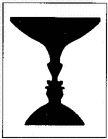

![]()
PRINCIPLE OF COMPLEMENTARITY
Some observations can never be made simultaneously. For example, one cannot see an electron as a particle and a wave at the same time. Two different experimental situations are necessary, and they cannot be realized simultaneously. The principle was first formulated by Niels Bohr. (Lefebvre, 1983, p. xxv)
![]() Principia Cybernetica. Principal of Complementarity
Principia Cybernetica. Principal of Complementarity
![]()
The information regarding the behaviour of one and the same object under mutually exclusive experimental settings may … , in an often-used expression within atomic physics, suitably be characterized as complementary, in that – although their description in everyday language cannot be subsumed into one whole – they nevertheless each express equally important aspects of the total sum of thinkable experiences regarding the object. (Bohr, 1957 [1938]: 38; authors’ translation)
![]()
We can define Bohr's idea (the viewpoint, argument, concept) of complementarity as a new epistemological framework for thinking across various fields of study ... the framework, which could serve both quantum theory and as a heuristic and methodical approach to any kind of scientific research. Generally speaking, some phenomenon (a subject of study) may be comprehensively described by means of two mutually exclusive languages (ideas, concepts, models, results of two experimental arrangements) La and Lb. Although one aspect of the given phenonmenon may be understood by means of La and another by means of Lb, there is no aspect of this phenomenon which would be describable simultaneously by means of La and Lb. Likewise the examined phenomenon does not correspond only to La or only to Lb, and La is not transferrable or derivable from Lb (or vise versa). Only within this complementary frame do certain paradoxes, principles, specific interpretations, dualities and incompatible pictures of nature gain their overall meaning... As a visual demonstration we can use, for example, the picture of the well-known Rubin's vase. At one moment, in the picture, we can see sharply and distinctly either a vase (La) or two profiles of a human head (Ld). We cannot derive the vase from the profiles; there is no causal connection to the vase, and vice versa. But for a complex understanding of the subject of study (Lab), i.e. for a complete perception of the picture, we must take into account both exclusive ways of perceiving it.
![]()

Please Note: This site meshes with the long pre-existing Principia Cybernetica website (PCw). Parts of this site links to parts of PCw. Because PCw was created long ago and by other people, we used web annotations to add links from parts of PWc to this site and to add notes to PCw pages. To be able to see those links and notes, create a free Hypothes.is↗ account, log in and search for "user:CEStoicism".
